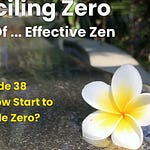Last Few Posts:
Terms In The Audio:
Zero: The fundamental teaching of the late Zen master Joshu Sasaki: “As the Buddha taught, zero inevitably splits into mutually opposing activities which inevitably disappear into zero.”
Reconciling Zero: The investigation of Zero in the pursuit of Effective Zen.
Effective Zen: The one path on Zen Mountain that gives any one individual the best chance of reaching the peak (realizing non-duality).
Zen Mountain: The collection of all possible Zen paths.
Buddhism: The set of spiritual activities where the highest good is the realization of non-duality.
Highest Good: That which exists for its own sake (there is nothing greater).
The Realization of Non-Duality: The complete understanding of a self inseparable from circumstance – where complete understanding implies manifestation.
The Realization of Infinite Mind: Same as the Realization of Non-Duality
Zero-Buddhism:
The preconditions necessary for Buddhism to arise, namely:
An enlightened teacher.
A clear picture of a path.
An understanding of the obstacles expected along this path.
The Effective Teacher
The effective teacher recognizes that, at some level, all of us seek perfect certainty, which ultimately manifests as the realization of infinite mind, and which is invariably obstructed by a misreading of the self.
The Five Aggregates
Form – which refers to the physical aspect of our being, and especially important for this discussion are our sense organs (eyes, ears, etc.)
Consciousness – which refers to our ability to sense (see, hear, smell, taste, touch, and think)
Perception – which refers to our cognitive abilities, which rely, of course, on consciousness
Feeling – which refers to how we react to what we perceive (positively, negatively, or neutrally)
Volition –which, based on feeling, refers to our ability to choose and act.
And so, we can see the five aggregates as a hierarchy of human endeavor that begins with form and results in choice and action.
The Essentials of Zero
Zero inevitably splits into mutually opposing activities (called plus and minus), which inevitably disappear back into Zero.
The plus and minus activities that constitute the “I am” self inevitably arise and disappear. There is no stopping that process. Period.
The activities of the “I am” self arising from the Zero self implies that requisite preconditions are present. That is, within the Zero self, some number of elements are needed before the activities of “I am” self can arise. Recall the example of fire, where zero fire represents the requisite preconditions needed for an actual fire to arise. We might say that oxygen and combustible materials are zero fire. Lack of oxygen or combustible materials means no chance of fire. The question then is, what are the requisite preconditions needed for the “I am self” to arise?
The length of time that the “I am” self manifests depends on the relative strengths of the opposing activities “I am” and “I am not.” For example, if the “I am” activity is much stronger than the “I am not” activity, the “I am” self may manifest for quite some time.
Read the Anattalakkana Sutta here.
Four Questions To Aid In Understanding the Anattalakkana Sutta
While very short, we can partition this sutta into six sections – a prolog, four logic presentations, and an epilog. Can you identify these six sections?
The Buddha makes the argument that the five aggregates are not-self. Note that Sasaki would use the term Zero self. What is the foundational logic of his claim?
The Buddha speaks of the activity of compelling – one making statements like “May my form be like this. May my form be not like that.” What generalization can we make about this activity of compelling?
In one section, the Buddha questions the suitability of statements like “This is mine, I am this, this is my self.” In the next section, the Buddha asserts that when it comes to the five aggregates, the proper attitude should be “This is not mine, I am not this, this is not my self.” How do these different perspectives fit into Joshu Sasaki’s teaching of Zero?
The Question For Next Week: Can we come to really appreciate the Anattalakkana Sutta?










